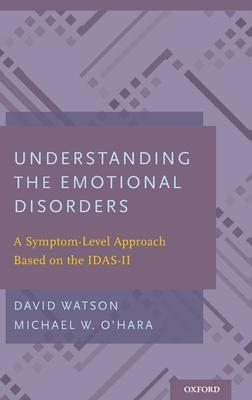Improving the measurement of symptoms of emotional disorders has been an important goal of mental health research. In direct response to this need, the Expanded Version of the Inventory of Depression and Anxiety Symptoms (IDAS-II) was developed to assess symptom dimensions underlying psychological disorders. Unlike other scales that serve as screening instruments used for diagnostic purposes, the IDAS-II is not closely tethered to the Diagnostic and Statistical Manual of Mental Disorders (DSM); rather, its scales cut across DSM boundaries to examine psychopathology in a dimensional rather than a categorical way. Developed by authors David Watson and Michael O’Hara, the IDAS-II has broad implications for our understanding of psychopathology.
Understanding the Emotional Disorders is the first manual for how to use the IDAS-II and examines important, replicable symptom dimensions contained within five adjacent diagnostic classes in the DSM-5: depressive disorders, bipolar and related disorders, anxiety disorders, obsessive-compulsive and related disorders, and trauma- and stressor-related disorders. It reviews problems and limitations associated with traditional, diagnosis-based approaches to studying psychopathology and establishes the theoretical and clinical value of analyzing specific types of symptoms within the emotional disorders. It demonstrates that several of these disorders contain multiple symptom dimensions that clearly can be differentiated from one another. Moreover, these symptom dimensions are highly robust and generalizable and can be identified in multiple types of data, including self-ratings, semi-structured interviews, and clinicians’ ratings. Furthermore, individual symptom dimensions often have strikingly different correlates, such as varying levels of criterion validity, incremental predictive power, and diagnostic specificity. Consequently, it is more informative to examine these specific types of symptoms, rather than the broader disorders. The book concludes with the development of a more comprehensive, symptom-based model that subsumes various forms of psychopathology-including sleep disturbances, eating- and weight-related problems, personality pathology, psychosis/thought disorder, and hypochondriasis-beyond the emotional disorders.
| FindBook |
有 1 項符合
Understanding the Emotional Disorders: A Symptom-Level Approach Based on the IDAS-II的圖書 |
 |
Understanding the Emotional Disorders: A Symptom-Level Approach Based on the Idas-II 作者:David/O’Hara,Michael W.,Watson 出版社:Oxford Univ Pr 出版日期:2017-04-20 語言:英文 規格:精裝 / 15.9 x 24.8 x 2.5 cm / 普通級 |
| 圖書館借閱 |
| 國家圖書館 | 全國圖書書目資訊網 | 國立公共資訊圖書館 | 電子書服務平台 | MetaCat 跨館整合查詢 |
| 臺北市立圖書館 | 新北市立圖書館 | 基隆市公共圖書館 | 桃園市立圖書館 | 新竹縣公共圖書館 |
| 苗栗縣立圖書館 | 臺中市立圖書館 | 彰化縣公共圖書館 | 南投縣文化局 | 雲林縣公共圖書館 |
| 嘉義縣圖書館 | 臺南市立圖書館 | 高雄市立圖書館 | 屏東縣公共圖書館 | 宜蘭縣公共圖書館 |
| 花蓮縣文化局 | 臺東縣文化處 |
|
|
圖書介紹 - 資料來源:博客來 評分:
圖書名稱:Understanding the Emotional Disorders: A Symptom-Level Approach Based on the IDAS-II
|









